THIAGI GAMELETTER:
April 2010
SERIOUSLY FUN ACTIVITIES FOR TRAINERS, FACILITATORS,
PERFORMANCE CONSULTANTS, AND MANAGERS.
TABLE OF CONTENTS
Masthead
Our mission statement, copyright notice, and cast
of characters.
In Memorium
Mel Silberman (1943-2010)
The passing of a great gamer.
Guest Gamer
Interview with Mel Silberman
Practical ideas from a prolific
author.
Jolt 1
Dot in a Circle by
Mel Silberman
Ask for feedback!
Tools
Serial Jolts
Repeated insights.
Jolt 2
Team Planning
What's your attitude toward planning?
Jolt 3
Teamwork
How productive is your team?
Say It Quick
Culture Crash by
Brian Remer
How new culture became normal.
Discoveries
Think Plastic by
Brian Remer
A review of The Brain that Changes
Itself.
Ideas
Brain Culture by
Brian Remer
How to learn your world-view.
Activities
Rearrange Your Brain by
Brian Remer
Challenge your culturally-wired
assumptions.
Zurich Workshops
Two Workshops in Switzerland
On training games—and positive
psychology.
Chicago Workshops
We Are Ready for Your Registration by
Tracy Tagliati
Learn interactive strategies and get
certified.
Single Topic Survey
Multitasking: Focusing Our Attention on Attention by
Tracy Tagliati
One thing at a time?
Survey Results
Evaluation by
Tracy Tagliati
Summary of your responses.
Thiagi Podcasts
New Podcast Episodes by
Matthew Richter
Listen to four new episodes.
Masthead
THIAGI GAMELETTER:
SERIOUSLY FUN ACTIVITIES FOR TRAINERS, FACILITATORS,
PERFORMANCE CONSULTANTS, AND MANAGERS.
Mission
To increase and improve the use of interactive,
experiential strategies to improve human performance in an
effective, efficient, and enjoyable way.
Editorial Roster
 Author and Editor
: Sivasailam (Thiagi) Thiagarajan
Author and Editor
: Sivasailam (Thiagi) Thiagarajan
 Assistant Editor
: Raja Thiagarajan
Assistant Editor
: Raja Thiagarajan
Associate Editor: Tracy Tagliati and Jean Reese
Contributing Editors: Brian Remer and Matthew Richter
Editorial Advisory Board: Bill Wake, Matthew Richter, Samuel van den Bergh, and <type your name here>
Copyright Info
The materials in this newsletter are copyright 2010 by The
Thiagi Group. However, they may be freely reproduced for
educational/training activities. There is no need to obtain
special permission for such use as long as you do not
reproduce more than 100 copies per year. Please
include the following statement on all reproductions:
Reprinted from THIAGI GAMELETTER. Copyright © 2010
by The Thiagi Group, Inc.
For any other use of the content, please contact us (
thiagi@thiagi.com ) for permission.
Subscription Info
To sign up, or to donate and help us continue this
newsletter, please see the Online
Newsletter page on our website (
http://thiagi.com/pfp.html ).
Feedback Request
Thiagi believes in practicing what he preaches. This is an
interactive newsletter, so interact already! Send us your
feedback, sarcastic remarks, and gratuitous advice through
email to thiagi@thiagi.com . Thanks!
[Table of
Contents]
In Memorium
Mel Silberman (1943-2010)
Dr. Mel Silberman, 67, Professor Emeritus at Temple
University, died peacefully at home on Saturday, February 20,
2010, after a valiant 13-year battle with lung cancer. He is
survived by his wife, Dr. Shoshana Silberman, three children,
and six grandchildren.
For thousands of teachers and trainers, Mel
was a source of idealism and ideas. As the popular professor
of Adult and Organizational Development at Temple University,
he taught for 41 years, winning two distinguished teaching
awards including the Great Teacher Award in
2000.
He has been a highly rated presenter and facilitator at
professional conferences, including ASTD, ISPI, Training, and
NASAGA.
A prolific author with 34 books to his credit, Mel's highly
original and influential 1990 book, Active
Training, introduced concepts related to
acquiring learning rather than receiving it. He
reinforced the concepts with the three volumes of
20 Active Training Programs. As the
President of Active Training in Princeton, NJ, Mel produced
and distributed several effective training activities that
that were used by teachers and trainers around the world. He
also published annual sourcebooks on training, performance,
and development with ready-to-use activities. Another
influential book edited by Mel is the Handbook of
Experiential Learning which contained chapters
from thought leaders in the field with models, guidelines, and
case examples that established the what,
why, and how of using activities to improve
training.
At NASAGA, Mel was a source of inspiration
and information. Over the years, he has made several
presentations at our conferences demonstrating his amazing
ability to walk the talk and use activities and debriefing
discussions to provide rich sources of engagement and
education. In addition, as Chris Saeger reminds us, “Mel was
a wonderful supporter of many NASAGANs. He provided
publishing opportunities to many of us through his
sourcebook series.”
NASAGA honored Mel with its most prestigious award, the
Ifill-Raynolds Life Time Achievement Award at our conference
in Atlanta in 2007. The citation that accompanied the
presentation emphasized Mel's “years of experience creating
and honing techniques that inspire learners to be people
smart, learn faster, and collaborate effectively.”
Personally, Mel has been a wonderful friend,
trusted colleague, and a great role model. Over the years, he
and I had a playful sibling rivalry going. I have contributed
to his edited publications and he has done the same for
me.
I remember the shock I had when Mel told me that he had been
diagnosed with lung cancer. But he did not let the cancer
hamper his passion and productivity. He took the time to visit
India and China with his wife Shoshana (whom he proudly
referred to as his high school sweetheart). Shoshana told me
that during his final year Mel continued writing and editing.
He insisted that someone should push his wheelchair so he
could facilitate a training workshop that was organized
earlier.
There is a single word that captures the essence of Mel:
mensch—a decent, upright, mature,
and responsible person. All of us in the gaming community will
miss you, Mel. And we will continue spreading the active
training revolution that you initiated.
[Table of
Contents]
Guest Gamer
 This a reprint of an interview with Mel
Silberman that was published in the September 1999 issue of
the Thiagi GameLetter. (In
those days, TGL was a print
newsletter rather than an online one.)
This a reprint of an interview with Mel
Silberman that was published in the September 1999 issue of
the Thiagi GameLetter. (In
those days, TGL was a print
newsletter rather than an online one.)
Interview with Mel Silberman
TGL: Mel, what's your specialty
area?
Mel: I like to figure out how any subject
matter can be taught actively through a variety of ways that
avoid lecturing. The use of games is one major way. To me,
real learning occurs when the participants do most of the
work. If you neatly package the information or elegantly
demonstrate the skills, you—not the
participants—are doing the work. The key to effective
training is to design the learning activities so that the
participants do the work and acquire knowledge and
skills rather than merely receive them.
TGL: When did you start designing and using
games?
Mel: Like most people who realize that
learning requires the participant's own mental involvement, I
have been dabbling with active methods for more than 30 years.
I got a Ph. D. in educational psychology back in 1968 after
spending four years listening to lectures about the
teaching-learning process! The only thing I clearly remember
was one professor saying, “Learning begins with a
question.” The problem was that he never encouraged his
students to ask questions. After my university days, I have
dedicated myself to finding ways of making learning happen. In
1990, I formalized my thinking with the first edition of
Active Training. Since then, it has
been a joyous ride of further experimentation and
writing.
TGL: In your active training sessions, where
do you use games?
Mel: I use games for the whole gamut of
learning: cognitive, behavioral, and affective. A game or
simulation can be used to illustrate a concept, to review
facts, to motivate people to practice skills, and best of all,
to open people's eyes, minds, and hearts to feelings, values,
and attitudes.
TGL: How do people respond to your use of
games?
Mel: Most of them love it. It is what they
remember the most and what makes the greatest impact in the
training session. They laugh a lot and even cry a little. Of
course, there are some who don't buy the analogies to real
life embedded in the games. However, that does not trouble me
too much because I believe that it is not all in the game.
What you do after the game is what really counts. To me, the
game just starts a conversation about something. You cannot
get to the same depth of conversation without the game. For
example, I once did a game about friendliness to customers
with a group of toll-booth collectors—all male and all
burnt out. They objected to the notion in the game that it is
a good idea to smile and be friendly as they collect tolls. I
asked them why and one person responded, “They know we were
just being put up to it. We could not possibly be for
real.” The conversation went on until I finally I got
them to agree to put “friendliness to customers” to a
one-week test. After a week, every person reported they liked
their job better! So, even a game that “bombed” produced
great results.
TGL: So what suggestions do you have for
debriefing after conducting games?
Mel: I like to use a three-stage sequence
called What? So What? Now What? After the game,
you ask participants to share what happened to them
during the game: What did you do? What did you observe?
What did you think about? What did you feel? Next ask
participants to ask themselves, “So what?”:
What benefits did you get from the game? What did you
learn? What did you relearn? What are the implications of
the game? How does the game related to the real world?
Finally, ask participants to consider “Now
what?”: How do you want to do things differently
in the future? How can you extend the learning you had? What
steps can you take to apply what you
learned?
TGL: Could you give us an example of how you
use this debriefing technique?
Mel: The Game of Life
is a popular game that is also known as the
Red-Blue Game. This game can be
played by six groups of any size. Each group should have
approximately the same number of players. The objective for
each group is “to win as much as you can”. There are six
rounds of the game. For each round, each group chooses either
X or Y (without knowing what the other groups have chosen) and
writes its choice on a slip of paper. All slips are handed to
the trainer who tallies them and announces the results. Each
group's payoff depends on the combination of choice made by
the groups. After the third and fifth rounds, allowance is
made for a 10-minute negotiation session among single
representatives from any group that wishes to participate. The
negotiations, if held, are to be loud enough for everyone in
the room to hear. Before these opportunities for negotiation,
the facilitator announces the payoff (wins and losses) will be
tripled for the fourth round and multiplied by ten for the
last round.
After playing The Game of Life,
participants will have many reactions, especially anger at
teams that did not cooperate and disdain for teams that used
deceit. Some participants may proclaim “It's only a game”
while others will take it very seriously.
During debriefing, in the What? stage of the
process, it is crucial to obtain these reactions and
observations in order to realize the potential of this
experiential activity. The biggest mistake is to analyze the
game too quickly before allowing feelings to be expressed.
After noting what happened during the game and what
participants were feeling, the facilitator guides the group
into the So What? stage. Here, participants begin
to develop insights. They note that the world is not simply
divided into good people and bad people. They understand that
behaviors could have occurred during the negotiations that
would have inspired trust and cooperation. They also observe
how groups that were losing heavily often behaved like victims
and failed to see that they had the power to turn their
fortunes around. After achieving these insights, participants
can now be helped to do some generalizing. Among the
principles that might emerge are these:
- All parties in an organization are responsible to create
its ultimate climate.
- The actions of one unit invariably affect the actions of
the others.
- Groups with power are reluctant to negotiate.
- Negotiation is most effective when each side
acknowledges its differences with others in a non-judgmental
fashion.
At this point, participants are usually motivated to start
applying the experiences to their own organization in the
final Now What? stage. This discussion can
address inter-group competition among different departments in
the same organization.
TGL: Finally, do you have any advice about
designing games?
Mel: Here are two simple suggestions: Make
sure that the game is relevant to the participants. And
instead of designing a game from scratch, modify an existing
game to suit your needs and objectives.
[Table of
Contents]
Jolt 1
(Reprinted from the print-only September 1999 issue of the
Thiagi GameLetter.)
Dot in a Circle
by
Mel Silberman
Purpose
To emphasize the importance of asking for feedback.
Time
10 to 20 minutes.
Materials
Several large envelopes, each containing the following
supplies:
Participants
Any number.
Flow
Create pairs. Assign one member of each
pair to be the Performer and the other to be the
Instruction Giver.
Distribute the envelopes. Give an envelope
to each Instruction Giver. Ask Instruction Givers to read
the directions silently.
Conduct the activity. Wait while the
Instruction Givers and the Performers complete the task.
Check the results. Ask if any Performer
requested feedback. Find out how well these Performers did
in comparison to those who did not ask for feedback. Point
out that the performance of those who asked for feedback is
significantly better.
Debrief the participants. Ask the group,
“What benefits do we obtain by asking for feedback
rather than waiting for it or not receiving it at
all?”
End with humor. Suggest that it is always
a good thing to ask for direct feedback: “Please tell me
if I have a piece of spinach between my front teeth rather
than making me pick up your nonverbal reactions and subtle
cues!”
[Table of
Contents]
Handout 1
Directions for Instruction Givers
Read these directions to yourself. Do NOT read or
show these instructions to the Performer.
- Ask the Performer to close her or his eyes.
- Give the Performer the sheet inside the envelope. Be
sure that the Performer is not peeking.
- Say: This sheet of paper contains a 2-inch circle. I
can't tell you where the circle is on the paper, but I'm
going to give you a dot. Take a guess and try to place the
dot inside the circle.
- Give a dot to the Performer. Wait while he or she places
the dot.
- Remain silent after the Performer completes the task.
Don't tell the Performer how well she or he did.
- If the Performer asks, “How did I do?” or “Did I
get the dot inside the circle?”, respond briefly in
general terms “Yes”, “No”, or “The dot is
touching the circle, but it is not inside.”
- If the Performer presses for details by asking questions
such as “Am I close?” or “How far away am I?”,
respond with specific information. For example, you could
say, “Your dot is an inch to the left of the
circle.”
- Tell the Performer that you have three more dots. Give
them one at a time. If you are never asked for feedback,
don't say anything. If you are asked for feedback, follow
the instructions given above.
- After all four dots are placed on the sheet, have the
Performer open her or his eyes and look at the
results.
[Table of
Contents]
Tools
Serial Jolts
A jolt is a brief experiential activity that
engages the participants and provides them surprising
insights. All jolts last for less than 5 minutes and they are
followed by debriefing discussions to maximize the learning
outcomes.
Serial jolts involve several activities that are
related to each other. Each jolt in the series is debriefed
before the next jolt is conducted.
Types of Serial Jolts
Same principle, different contexts
While participants receive brilliant insights through a
jolt, very few of them are able to apply what they learned
from a single jolt to similar real-world situations.
Serial jolts provide repeated and varied practice.
Here's an example: Six Tiles uses
serial jolts to increase participants' awareness of
unnecessary assumption they make while solving problems.
The first jolt involves displaying six tiles, each with
three letters:
MAN
LES
OBJ
AGE
SON
ECT
The participants are asked to rearrange the tiles to
spell three words. This puzzle is solved easily:
MANAGE
LESSON
OBJECT
The jolts that follow are of the same type and they all
begin with the presentation of six tiles of three letters.
However, each jolt traps participants into making a
different type of unnecessary assumption such as all tiles
have to be used, the resulting words must be in English,
the tiles may not be rotated, each tile must be used only
once, there should be a space between words, and so on. By
the time participants experience these fast-paced jolts,
they become justifiably paranoid about the assumptions
they are mindlessly making in solving common problems.
Different principles, similar contexts
This type of serial jolt emphasizes the point that the
strategy that worked for solving one problem may not work
with other problems. Here is an example of a serial jolt
called Hasty, which warns people
against falling into a rut.
During the first jolt, participants are presented with
these words:
NEW DEER
They are asked to rearrange the seven letters in these
two words to spell one word. After some serious thinking,
most participants discover the solution:
RENEWED.
Participants are given these two
words:
NEW DOOR
and
the same instructions.
After several frustrating attempts, most participants
give up. The facilitator reveals this solution
ONE WORD
which literally
complies with the instructions.
During the debriefing discussion, the facilitator points
out that what worked before may not work now.
Controlling contextual factors
This type of serial jolt involves using the same basic
set up with minor variation. This enables participants to
realize how a change in one of the factors influences
behaviors and outcomes.
Here's an example: In Team Poker,
each participant is given a random playing card. Within a
3-minute time limit, participants are asked to team up in
groups of five with the best poker hand. During the second
jolt, players receive a new random playing card and given
the same task. However, in this round, each member of the
winning team receives a $5 cash award. The third round is
similar to the second one except members of the winning
team receive different amounts as cash awards.
Dividing up a length simulation
Very often a lengthy simulation can be divided into a
series of shorter jolts. This strategy permits
just-in-time debriefing discussions at the end of each
phase of the activity. For example, if a team activity in
a simulation involves planning, implementing, and
improving the process, we may divide the simulation into
three related jolts each ending with an appropriate
debriefing discussion.
Words of Caution
Serial jolts may also present some special challenges. Here
are a couple of things to watch out for:
Using a series of entrapment jolts may frustrate the
participants and make them feel you are torturing them. They
may grow hostile and impatient and scream, “We get the
point. Why don't you leave us alone?” The best action
at this stage is to leave them alone. Just summarize what
the other jolts involve and how other participants usually
behave. This permits your participants to learn vicariously
without frustrating themselves.
When you divide a lengthy simulation game into a series of
jolts, each jolt may not have a clear-cut conclusion.
Participants may want to find out who won the jolt. They may
also be eager to move on to the next logical phase of the
activity without the delay of participating in a debriefing
discussion. So it is important for you make each jolt a
self-contained activity with a logical ending.
In spite of these limitations, when used appropriately,
serial jolts can be more effective than single jolts or
lengthy simulations.
[Table of
Contents]
Jolt 2
Team Planning
Here's a jolt that explores how people plan to complete team
projects.
Synopsis
Participants are introduced to a novel task of solving
micro-sudoku puzzles. They are asked to plan an
efficient procedure for solving this type of puzzles while
working in teams. During the debriefing discussion, elements
of different plans are compared.
Purpose
To explore how teams plan for completing a challenging
activity.
Training Topics
Team planning. Teamwork. Planning for novel tasks.
Brainstorming. Decisionmaking.
Participants
Six or more. Best number is 12 to 30.
Time
3 minutes for the activity. 3 to 10 minutes for
debriefing.
Handout
How To Solve Micro-Sudoku
Puzzles, one copy for the facilitator
Supplies
- Countdown timer
- Flipchart
- Felt-tipped pens
Preparation
Read the handout, How To Solve Micro-Sudoku
Puzzles. Become familiar with solving this type of
puzzle.
Draw this micro-sudoku puzzle on a flip chart:
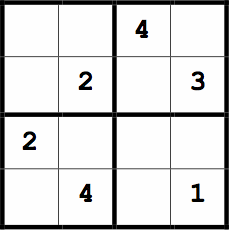
Caution
This is a safe planning exercise.
Flow
Brief the players. Ask how many
participants have experience solving sudoku puzzles. Tell
participants that most people are familiar with the 9 x 9
sudoku grids. In this activity, you are going to use an
easier 4 x 4 micro sudoku grid.
Explain how to solve the puzzle. Use the
micro-sudoku grid that you prepared on the flip chart paper.
Explain that the puzzle is solved by placing the numbers 1
to 4, one number in each box so that each column, each row,
and each 2 x 2 area includes all four numbers. Using a felt
pen of a different color, ask participants to help you solve
the puzzle.
Organize participants into teams. Organize
participants into teams of 2-5 members. (It does not matter
if a few teams have one more member than the others.)
Explain the team challenge. Tell
participants that they will receive a set of 30 micro-sudoku
puzzles. Working as a team, they should solve as many sudoku
puzzles as possible. However, before they begin dong that,
the teams should spend 3 minutes planning the best way for
them to undertake the task.
Conduct the planning activity. Set the
countdown timer for 3 minutes and start it. Ask the teams to
plan their puzzle-solving strategy. Remind them that they
have 3 minutes for this planning activity.
Conclude the planning activity. Blow the
whistle at the end of 3 minutes to announce the end of the
planning period. Randomly select a team and ask its
spokesperson to present the highlights of the plan. Then ask
the spokespersons from the other teams to present unique
features of their plans.
Debriefing
Invite participants to comment upon the similarities and
differences among the elements of different plans. Continue
with discussion questions similar to these:
- Did you have enough time for planning?
- How many of you felt that planning did not add value
in this situation?
- The team challenge involved a novel activity. Is
planning more important or less important when you have
this type of novel activity?
- The team challenge involved a specific time-bound
activity. Is planning more important or less important
when you have this type of specific activities?
- Did you plan to assign different responsibilities to
different members of the team? If so, how did you make
this decision?
- How did different members of your team participate in
the planning activity?
- What are some possible reasons for different levels of
participation among team members?
- How did your planning procedure resemble other
planning activities in your workplace?
- If you were to conduct the planning activity again,
how would you do it differently?
- Are you planning to add ideas from the other teams to
your team's plan?
- Did you discuss the advantages and disadvantages of
each team member working alone on a puzzle assigned to
her, or two team members tackling the same puzzle, or all
team members tackling the same puzzle?
Learning Points
Different people have different approaches to planning.
Some people don't see any value in planning. They want to
jump immediately into action.
Variations
Don't feel comfortable about explaining how to
solve the puzzles? Make copies of the handout,
How To Solve Micro-Sudoku Puzzles and
distribute one copy to each participant. Give them some time
to read the handout and figure out how to solve the
puzzles.
Field Notes
When we use this jolt as a stand-alone activity, some
participants feel disappointed because they do not get to
solve the puzzle. So it is good idea to follow up with the
next jolt that involves solving mini-sudoku puzzles.
However, don't skip the debriefing activity; it produces
interesting insights into people's reactions to
planning.
[Table of
Contents]
Handout 2
How To Solve Micro-Sudoku Puzzles
Sudoku puzzles, with their 9 x 9 grids, keep showing up
everywhere: books, in-flight magazines, newspapers, and
websites. If you are frightened of these puzzles or worried
about becoming addicted to them and wasting your time, we have
just the thing for you: micro-sudoku puzzles with 4 x 4
grids.
Here's a sample micro-sudoku puzzle:
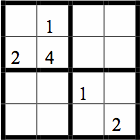
To solve the puzzle, you have to place the numbers 1 through
4 in each of the blank boxes in such a way that each number
appears only once in each column, each row, and each 2 x 2
block (surrounded by thicker lines).
Given this requirement, you can logically solve the puzzle.
However, if you want some help, you can watch me as I figure
out the placement of the some of the numbers. In the following
step-by-step progression, figure out how I placed in the
number in the gray box:
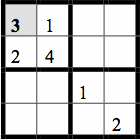
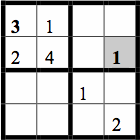
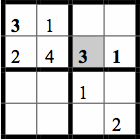
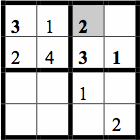
You should be able to figure out the rest of the grid. Here's
the final solution:
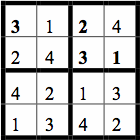
[Table of
Contents]
Jolt 3
Teamwork
Here's a jolt that explores how people work together to
complete team projects. This jolt is a follow up activity to
the earlier jolt, Team
Planning.
Synopsis
Participants work in teams and solve as many micro-sudoku
puzzles as possible within 2 minutes.
Purpose
To explore how teams work together to complete a
challenging activity.
Training Topics
Teamwork. Implementing plans. Collaboration.
Participants
Six or more. Best number is 12 to 30.
Time
2 minutes for the activity. 5 to 10 minutes for
debriefing.
Handouts
A collection of 30
Micro-Sudoku puzzles (12KB PDF), one copy for each
participant
Supplies
Prior Activity
Conduct the earlier jolt, Team
Planning, and debrief the participants before
conducting this jolt.
Caution
This is a safe team-based exercise.
Flow
Distribute the puzzles. Give a copy the
handout with 30 micro-sudoku puzzles to each participant,
with the printed side facing down. Ask participants not to
look at the puzzles until you announce the beginning of the
puzzle-solving activity.
Brief the participants. Tell them that
they have 2 minutes to work as a team to solve as many
different puzzles as possible. Explain that working as a
team does not require all team members to participate in
solving each puzzle.
Conduct the puzzle-solving activity. Set
the countdown timer for 2 minutes and start it. Tell the
teams to begin solving the puzzles. Remind them that they
have 3 minutes for this activity.
Conclude the puzzle-solving activity. Blow
the whistle after 2 minutes to announce the end of the
puzzle-solving period. Ask each team to count the total
number of puzzles solved by its members and announce this
total. Identify the team that solved the most puzzles and
congratulate its members.
Debriefing
Conduct a discussion with the participants by asking
questions similar to these:
- Did you stick to your original plan or change
it?
- Did you consider yourself competing with the other
teams? How did this competition influence your
teamwork?
- How do you feel about the team that solved the most
puzzles? What do you think is the secret of their
success?
- Did the team members work individually or as a
team?
- How did you divide the task among different members of
the team?
- What interesting things did you learn about your
teammates?
- How did you coordinate the activities of different
team members?
- Did anyone take charge of the team?
- How much time was spent in coordinating the teamwork?
How much time was spent in the actual puzzle-solving
activity?
- Did the task of solving the puzzles lend itself to
teamwork?
- Which would have been more productive: Five people
working individually in solving the puzzle or five people
working together as a team?
- If you were to repeat the puzzle-solving activity,
what recommendations would you make to your team?
- In what ways does the puzzle-solving activity reflect
team activities in your workplace?
Learning Points
Very few plans can withstand the impact with reality.
It is good to spend time in planning activities, but it is
bad to be completely controlled by a plan.
Plans must be implemented in a flexible fashion to make use
of new opportunities.
Variations
Do you want to use this as a stand-alone
jolt? If you want to skip the previous jolt
(Team Planning), make copies of the
handout, How To Solve
Micro-Sudoku Puzzles and distribute one
copy to each participant. Give them a couple of minutes to
read the handout and figure out how to solve the puzzles.
Then distribute the puzzle sheets and get them started on
solving them.
Field Notes
The number of different puzzles solved by teams of five
members ranges from 6 to 10. The current record is 16
different puzzles. So don't worry about teams running out of
puzzles to solve during the 2 minute period.
[Table of
Contents]
Say It Quick
Culture Crash
by
Brian Remer
Learn about the way your brain controls your mind—and,
beginning with this 99-Word story, the unexpected consequences
that might result.
Culture Crash
After two years of driving in the congested, chaotic
traffic of Ecuador, my wife could not adjust to the traffic
patterns at home. The high speed weaving and dodging that
was an effective strategy abroad was downright dangerous in
the US. Behind the wheel, she found it difficult to change
her habits.
Here was a reminder of how easily we adopt the culture we
find ourselves in. With enough exposure, nearly any behavior
becomes “normal.”
Do we make conscious decisions about the cultural elements
that surround us? Do we shape organizational culture or let
ourselves be shaped?
[Table of
Contents]
Discoveries
Think Plastic
by
Brian Remer
Your brain is plastic. It's not made of plastic, of course,
but it behaves as if were. That's the term author Norman Doidge repeatedly uses in his book,
The Brain That Changes Itself, to
talk about the amazing physical adaptations the human brain
makes. By plastic, Doidge means that our brains can easily and
quickly adapt to new demands. And those adaptations happen
physically, on the cellular level, resulting in new neurons
and ever more intricate synaptic connections between them.
This plasticity accounts for the brain's ability to recover
functions that have been lost as a result of a stroke or other
injury. But plasticity also accounts for the difficulty we
experience in trying to change a bad habit because habits are
literally molded into the very structure of our brain. Doidge
gives equal evidence for both the positive and negative
effects of brain plasticity.
Plasticity in Action:
“Imagining an act engages the same motor and sensory
programs that are involved in doing it. … Each
thought alters the physical state of your brain synapses
at a microscopic level.” p. 212
In one organization, workers who support people who are
blind live with their eyes cut off from all light during
their training period. In as little as one week's time,
their occipital lobes show evidence of rewiring to take on
other functions.
People who have had a stroke are often able to retrain
their brains so that some of the processing of the damaged
area is distributed to other areas of the brain.
Physical exercise actually creates brain stem cells.
Learning helps new neurons live longer. Combine exercise
and learning and you have a recipe for promoting brain
health into old age. P. 253
Watch a lot of TV and your brain will rewire itself to
adapt to the abrupt changes that have been written into
the TV programming to occur several times a minute. For
young children especially, this results in symptoms
similar to Attention Deficit Disorder.
On one hand, it's not surprising why we behave certain ways.
We know that old habits are hard to break, that if you
surround yourself with negativity you'll become a more
negative thinker, and that if you really want to learn
something well, you have to practice. But this book gives a
physiological reason for these experiences. It explains that
all of our experiences create changes in the cellular
structure of our brain and that those physical changes,
because they affect our emotions, memories, and perceptions,
actually begin to change our reality.
The book is The Brain that Changes
Itself by Norman Doidge, M.D. Penguin Books,
2007. ISBN 978-0-670-03830-5 .
[Table of
Contents]
Ideas
Brain Culture
by
Brian Remer
One principle Doidge often refers to is the
“use-it-or-lose-it” quality of the brain. This means
that whether we are talking about neuronal connections or
whole areas of the brain, whatever is used becomes stronger.
If an area or connection is not used for a particular
function, it will be “lost” to that function and used for
something else. Similarly, if we put more energy into using
certain connections or brain areas, they will become stronger
and even more specialized for that purpose.
An interesting example of this is the sum total of our world
view, or culture. We create our culture as a people but as
individuals, we learn our culture from family, friends,
society, and so forth. Our brains create culture but culture
also molds and creates our brain. Doidge explains that when
people were asked to recall pictures of undersea wildlife,
those from individualistic cultures talked about specific fish
and what they did. People from collectivistic cultures
described groups of fish and how they interacted with the
whole environment. In addition, each group used a different
region of their brain to describe what they were recalling.
Individualistic and collectivistic cultures actually wire the
brain to see the world a certain way.
As we learn a culture, we teach our brain to see the world a
very specific way and our brain responds by changing its
structure. It then becomes a finely tuned instrument for
interpreting the world from that cultural perspective. As long
as you stay in your own culture, you'll be fine. But in a new
culture, what was once adaptive can become counterproductive
or even dangerous! This month's 99-Word story is a case where my wife had been so
successful at molding her brain for Ecuador that she had
trouble making a reconnect for the U.S. format.
For another example of the challenges involved in
reprograming one's brain for another culture, see the February/March 2009 issue of the Firefly News Flash.
If it reminds you of your own challenges in personal brain
restructuring, please share your story (email Brian)!
[Table of
Contents]
Activities
Rearrange Your Brain
by
Brian Remer
The function of an arm or leg muscle is to move your body.
Muscles grow by doing what they do best: moving. The function
of your brain is to think. It grows by doing what it does
best: thinking.
Here's a game to grow your brain by challenging culturally
wired assumptions. Can You Explain It?
is based on what's called the fundamental attribution error,
which is the tendency to hold onto one's first conclusion
about a situation rather than testing for alternative
explanations.
This is how we'll play. I'll give you an observation in the
form of a statement. You think of an explanation for it. Then
click to get the answer and your score. As you play, see if
you can stretch you synaptic connections to invent answers
that are more varied and inventive while staying within
generally accepted standards of reality (no Klingons or
paranormal phenomena, please!)
Can You Explain It?
Observation #1: A married woman goes to a single man's
apartment two nights of every week for three hours. What's
your explanation? Click for your
score.
Observation #2: Two police officers
visit your next-door neighbor's house. What's your
explanation? Click for your
score.
Observation #3: A person smelling
of stale liquor is buying aspirin at 6 a.m. What's your
explanation? Click for your
score.
Observation #4: When you get home
you find your brother's car is dented in on the right side.
What's your explanation? Click for
your score.
Observation #5: You see a man
chasing a woman down an alley. What is your explanation?
Click for your score.
Observation #6: A teenager carrying
a heavy backpack runs out the door of a convenience store.
What's your explanation? Click for
your score.
Observation #7: Two clean-cut young
men wearing dark slacks and white shirts ring your doorbell.
What's your explanation? Click for
your score.
Observation #8: It's dinnertime and
the phone rings. A pleasant person on the line asks for you
but mispronounces your name. What's your explanation? Click for your score.
Observation #9: Last week a
mechanic fixed the vibration in your car's front end. Now
you feel the vibration again. What's your explanation? Click for your score.
Observation #10: Your boss and the
director of personnel are moving boxes out of your friend's
office. What's your explanation? Click for your score.
Observation #11: You are driving
down the street when a car in a side driveway suddenly cuts
in front of you. What's your explanation? Click for your score.
Observation #12: You're sitting in
the airport waiting for a flight. When you reach for your
newspaper, the person next to you is reading it. What's your
explanation? Click for your
score.
How well did you score, and more importantly, what did you
learn?
- How does Can You Explain It?
challenge our common assumptions?
- What is the basis of some of the worst assumptions you
made in this game?
- To what extent did your explanations for the
observations become more creative and less stereotyped as
you played the game?
- What are some of the potential problems of the
fundamental attribution error?
- Describe some strategies for overcoming the shortfalls
of holding onto assumptions.
- What are the factors that make us vulnerable to making
wrong conclusions?
- What types of real life situations might make us
especially susceptible to this type of thinking
error?
- What are the implications of what you have learned for
scientists, law enforcement officers, news reporters,
managers, and school teachers who rely upon observable data
for making conclusions?
Did you enjoy playing Can You Explain
It? Did you rearrange any brain cells? If so,
please let me know (email Brian) and help me rearrange some of
mine!
[Table of
Contents]
Zurich Workshops
Two Workshops in Switzerland
Van den Bergh Thiagi Associates are happy to offer their
annual workshops in Winterthur, Switzerland (near Zurich).
Workshop 1: Interactive Training Strategies
June 7-9, 2010 (three days)
This workshop is designed for trainers, instructional
designers, facilitators, managers, and performance
consultants. The workshop helps a wide range of
practitioners, from newcomers to experienced specialists, to
master skills and concepts related to different types of
training games, simulations, and learning exercises.
This workshop practices what it preaches. Participants
learn new principles and procedures and apply them to
creating and conducting different types of learning
activities that meet their training objectives, audiences,
and needs.
Workshop 2: Evidence-Based Positive Psychology
Activities
June 10-11, 2010 (two days)
This workshop is designed for trainers who want to
incorporate innovative concepts and approaches from positive
psychology and for people who want to improve the quality of
their personal and professional life.
In this workshop, Thiagi offers two dozen proven and
powerful activities from positive psychology and supports
them with a conceptual framework. You learn how to measure,
increase, and sustain your happiness. You also learn how to
help other people to be more positive and improve their
health and productivity. This is not an inspirational
touchy-feely seminar but a workshop that incorporates
evidence-based facts, concepts, and techniques.
See the brochure (1.3meg PDF) for more information.
[Table of
Contents]
Chicago Workshops
We Are Ready for Your Registration
by
Tracy Tagliati
 Interactive Techniques for Instructor-Led
Training, a 3-day workshop conducted by
Thiagi and Tracy, is scheduled for July 26-28 in Chicago,
Illinois.
Interactive Techniques for Instructor-Led
Training, a 3-day workshop conducted by
Thiagi and Tracy, is scheduled for July 26-28 in Chicago,
Illinois.
A 1-day certification workshop (that licenses you to conduct
this workshop) will be held on July 29, 2010.
If you register now, you save $370 for the 3-day workshop
and $125 for the 1-day certification program.
Here are some additional details about these workshops. You
can also download a detailed brochure (298k PDF).
Location
Courtyard by Marriott Chicago Downtown/Magnificent Mile
(http://www.courtyardchicago.com/ )
165 E
Ontario Street
Chicago, IL 60611
USA
Telephone: (312) 573-0800
Registration Fees
3-Day Workshop (July 26-28): $1,495.
1-Day Certification Workshop (July 29): $495.
Early Bird Discount
If you register before May 11, 2010
- 3-Day Workshop: $1,125 (Save $370)
- 1-Day Certification Workshop: $370 (Save $125)
Group Discount
Groups of three or more who enroll at the same time will
get a 15 percent reduction of their registration fees.
Two Easy Ways to Register
Online. Visit our online store at
thiagi.com and click on “Workshops: 2010”. (You will automatically
be given the early bird discounted fee.)
Telephone. Call (812) 332-1478.
What You Get for Your Registration Fee
3-Day ITILT Workshop
- Manual, Interactive Techniques for
Instructor-Led Training
- Manual, Simulation Games for
Instructor-Led Training
- Additional handouts
- Continental breakfast
- Two refreshment breaks
- Certificate of Accomplishment
- Access to Thiagi's web site
- One-year subscription to the Thiagi
GameLetter
1-Day Certification Workshop
- Book, Framegames by
Thiagi
- Book, Simulation Games by
Thiagi
- Additional handouts
- CD-ROM with Handout Masters
- Set of slides
- Licensing Agreement
- Access to Thiagi's web site
- One-year subscription to the Thiagi
GameLetter
- Listing on Thiagi's website as a certified
trainer
- Discount on Thiagi's books and games for use in your
workshops
- Certificate of Accomplishment
More Information
Please download our detailed brochure (298k PDF).
[Table of
Contents]
Scores
Scores for Rearrange Your Brain
Can You Explain It? Observation
# 1
| If your answer was similar
to… |
Give yourself… |
| The two are having an affair. |
0 points |
| She is his cleaner. |
1 point |
| She is his mother and is caring for him while he is
sick. |
2 points |
| He is a music teacher and she goes there for piano
lessons. |
3 points |
| (Any answer that is more creative.) |
4 points |
Back to the next
observation
Can You Explain It? Observation
# 2
| If your answer was similar
to… |
Give yourself… |
| The police officers are questioning your neighbors
about some dreadful crime they have committed. |
0 points |
| The police officers are visiting the house because
the neighbors are their friends. |
1 point |
| The neighbors are, themselves, police
officers. |
2 points |
| The police officers are asking questions about
YOU! |
3 points |
| (Any answer that is more creative.) |
4 points |
Back to the next
observation
Can You Explain It? Observation
# 3
| If your answer was similar
to… |
Give yourself… |
| The person was out partying all night and has a
headache as a result. |
0 points |
| The person is buying aspirin for their partner who
has the flu. |
1 point |
| The person works in Johnny's Blues Bar and has just
finished the late shift. |
2 points |
| The person spilled a bottle of rum when trying to
reach the breakfast cereal bumped their head on the open
cupboard and are looking for a remedy. |
3 points |
| (Any answer that is more creative.) |
4 points |
Back to the next
observation
Can You Explain It? Observation
# 4
| If your answer was similar
to… |
Give yourself… |
| Your brother just had an accident. |
0 points |
| The car has always been like that for several days
and you never noticed. |
1 point |
| Old VW's always look like that. It's the same on the
other side. |
2 points |
| The car is full of rust. This was bound to
happen. |
3 points |
| (Any answer that is more creative.) |
4 points |
Back to the next
observation
Can You Explain It? Observation
# 5
| If your answer was similar
to… |
Give yourself… |
| You are witnessing a case of domestic
violence. |
0 points |
| She is a shoplifter; he is a plain-clothes
officer. |
1 point |
| They are trying to catch their dog. |
2 points |
| The two are practicing for a marathon. |
3 points |
| (Any answer that is more creative.) |
4 points |
Back to the next
observation
Can You Explain It? Observation
# 6
| If your answer was similar
to… |
Give yourself… |
| The teenager just robbed the store. |
0 points |
| The teenager is late for class. |
1 point |
| The teenager is a track star and runs
everywhere. |
2 points |
| The store is on fire. |
3 points |
| (Any answer that is more creative.) |
4 points |
Back to the next
observation
Can You Explain It? Observation
# 7
| If your answer was similar
to… |
Give yourself… |
| They are proselytizing for a religious group. |
0 points |
| They are asking for directions. |
1 point |
| They are canvassing the neighborhood for a voter
registration effort. |
2 points |
| They are members of the high school choral group
with information about their next performance. |
3 points |
| (Any answer that is more creative.) |
4 points |
Back to the next
observation
Can You Explain It? Observation
# 8
| If your answer was similar
to… |
Give yourself… |
| It's a telemarketer interrupting your dinner. |
0 points |
| It's your Malaysian friend who always mispronounces
your name. |
1 point |
| It's a call from your friend, a practical joker
always giving you a hard time. |
2 points |
| You are waiting outside a popular restaurant and the
hostess is calling on your cell phone to tell you your
table is ready. |
3 points |
| (Any answer that is more creative.) |
4 points |
Back to the next
observation
Can You Explain It? Observation
# 9
| If your answer was similar
to… |
Give yourself… |
| The mechanic did a poor job. |
0 points |
| You recently drove through wet, muddy roads and mud
is now caked onto the suspension system. |
1 point |
| You are driving over those bumpy warning strips in
the road. |
2 points |
| Your teenager damaged the tires while learning to
parallel park. |
3 points |
| (Any answer that is more creative.) |
4 points |
Back to the next
observation
Can You Explain It? Observation
# 10
| If your answer was similar
to… |
Give yourself… |
| Your friend just got fired. |
0 points |
| Your friend got a promotion and is moving to another
part of the building. |
1 point |
| Your boss has decided not to keep company documents
in your friend's office any longer. |
2 points |
| The boxes should have been delivered to the
personnel director's office. |
3 points |
| (Any answer that is more creative.) |
4 points |
Back to the next
observation
Can You Explain It? Observation
# 11
| If your answer was similar
to… |
Give yourself… |
| The driver is an aggressive, rage-filled road
warrior. |
0 points |
| The sun was in the driver's eyes so they didn't see
you. |
1 point |
| The driver is inexperienced using a clutch. |
2 points |
| The car was hit from behind and was pushed into your
lane. |
3 points |
| (Any answer that is more creative.) |
4 points |
Back to the next
observation
Can You Explain It? Observation
# 12
| If your answer was similar
to… |
Give yourself… |
| The person has stolen your newspaper. |
0 points |
| The person thought the paper had been
abandoned. |
1 point |
| The person thought the paper belonged to their
friend. |
2 points |
| The paper belongs to the other person. Yours is
still in your carry-on! |
3 points |
| (Any answer that is more creative.) |
4 points |
Back to Rearrange Your
Brain
[Table of
Contents]
Single Topic Survey
Multitasking: Focusing Our Attention on Attention
by
Tracy Tagliati
 Participants' minds have always had the
ability to wander, but now it is happening at warp speed. This
is due in large part by the deluge of electronic devices that
have become indispensable social accessories. It's not
uncommon to have a participant in a workshop who is
alternating between listening to you, texting her friends on
the iPhone, and searching for something on Google.
Participants' minds have always had the
ability to wander, but now it is happening at warp speed. This
is due in large part by the deluge of electronic devices that
have become indispensable social accessories. It's not
uncommon to have a participant in a workshop who is
alternating between listening to you, texting her friends on
the iPhone, and searching for something on Google.
Some people confidently think they are accomplishing more in
their day, and get a buzz out of multi-tasking. Others believe
that multitasking has its limitations and might actually slow
you down.
How about you?
Poll Question
Are you a multitasker?

(The poll opens in a new window.)
Do you think multitasking is more productive than focusing
on one thing at a time?

(The poll opens in a new window.)
Open Question
What do you think are the advantages and disadvantages of
multitasking?

(The survey opens in a new window.)
Send us your thoughts and ideas. You may choose to include
your name along with your response, or if you prefer, keep
it anonymous.
We asked this question during a recent workshop, and here's
what a few participants had to say:
Emma: The problem with multitasking is
that when people appear to be able to do more, their
managers expect them to do more. Sometimes that becomes
difficult to maintain.
Brian: I think multitasking varies from
one person to another. Some people seem to be better at in
than others. I let my participants judge for themselves
which kind of learner they are.
Erin: I have made peace with this new
world of skimming and multitasking. I think that with more
practice our brains are getting better at making conceptual
connections across a wide variety of domains.
Jonathan: I think there's a time when it
is important to focus on just one thing and there's a time
when multi-tasking is OK. I turn off everything when I am
doing my taxes or writing a report. But when I am
downloading a large file, or updating my Itunes, I will
probably also be checking out Facebook.
Dina: Try this test and then tell me if
you think multi-tasking is a good thing. Recite the letters
A through J as fast as possible, and then the numbers 1
through 10. If you timed yourself you probably noticed that
each of those tasks takes about three seconds. Now,
interweave the two recitations as fast as you can: “A, 1,
B, 2,” and so on. Does that take six seconds? No. If
you are like most people, it probably took you 20 to 30
seconds, and even then you probably made some mistakes.
[Table of
Contents]
Survey Results
Evaluation
by
Tracy Tagliati
 Last month we asked you if you regularly
evaluate your training activities.
Last month we asked you if you regularly
evaluate your training activities.
Here's how you responded:

(Percentages reflect votes received by March 23, 2010.)
We also asked you what obstacles you face when evaluating a
training activity and how you handle them.
We had some great responses. Here's what some of you had to
say:
Response 2) My own prejudices.
I handle them by remembering that all participants and
groups are perfect…
except the ones that dislike my activities!
Response 14) There should be no training without proper
evaluation. The evaluation begins up front with the
objectives to the training. When writing proper objectives
of “why” you are having to have a training (i.e. What
is the business problem you are trying to solve) and you
answer it with numbers (such as reduce cost, increase # of
participants, reduce attrition %, etc) you can then evaluate
current state numbers and future state numbers, at least at
level 2 or 3 of the Kirkpatrick or Phillips Models.
Response 5) I have a hard time getting buy-in from other
stakeholders. Additionally, I have a hard time with people
making misinformed decisions based on my data. I'm
collecting data for managers higher up the totem-pole than
me, and they misinterpret the data and misrepresent it. I
also have a hard time with my organization dismissing all
qualitative data and only accepting the quantitative data.
But the culture is slowly changing.
Response 7) Obstacle: My own fears (what if I am found to
be lacking) But I tell myself, it is better to know now
rather than later.
And then fears from the clients, who also don't want to
rock the boat.
See more of the reader's responses or add your own.
Thank you for your responses.
[Table of
Contents]
Thiagi Podcasts
New Podcast Episodes
by
Matthew Richter
 Since the last TGL, we have
uploaded four new episodes: two for our Training Intelligence
Podcast and two for the Business Intelligence Podcast. All
podcasts can be subscribed or listened to from either iTunes
or at http://thiagi.net/podcasts/ . Feel free to send Matt
any feedback or suggestions at matthew@thiagi.com
.
Since the last TGL, we have
uploaded four new episodes: two for our Training Intelligence
Podcast and two for the Business Intelligence Podcast. All
podcasts can be subscribed or listened to from either iTunes
or at http://thiagi.net/podcasts/ . Feel free to send Matt
any feedback or suggestions at matthew@thiagi.com
.
Episode 4: Who Is Thiagi?
In this special
episode, Thiagi talks about how he became a trainer and
instructional designer. He shares with Matt some anecdotes
about moving to the United States from India and some
perilous time in Africa. Learn how Thiagi created a whole
class of car thieves during his first custom simulation, and
find out why Thiagi is so passionate about what he does.
Episode 5: Rapid Instructional Design
In
this episode, Thiagi explains Rapid Instructional Design
(RID) and how it is a faster, cheaper, and better way to
create and facilitate learning. He uses Matt as a faux
client, role playing how he designs so quickly. He also
answers many of the popular concerns surrounding RID.
Episode 3: Laurie Orlov: Aging in Place and Why
Businesses Should Care
In our third episode,
Founder and Principal Analyst Laurie Orlov of the Aging in
Place Watch is our guest. Laurie explains how we are
approaching a $20 Billion market for products and services
that help seniors stay in their homes as they age. She
discusses why companies should pay attention to the risks of
employees having to manage the impact of elder care. And,
she highlights other aging issues beyond the technological
ones that affect businesses.
Episode 4: Rick Nelson: Recruiting and the Job
Markets
In our fourth episode, recruiting
expert Rick Nelson joins Matt for a conversation about how
the recession really affected the job markets
(hint—you already know the answer, but here are some
details), the recovery and when it will hit employment, how
companies look at prospective candidates, and how a
candidate should approach getting a job.
[Table of
Contents]
 Author and Editor
: Sivasailam (Thiagi) Thiagarajan
Author and Editor
: Sivasailam (Thiagi) Thiagarajan Assistant Editor
: Raja Thiagarajan
Assistant Editor
: Raja Thiagarajan This a reprint of an interview with Mel
Silberman that was published in the September 1999 issue of
the Thiagi GameLetter. (In
those days, TGL was a print
newsletter rather than an online one.)
This a reprint of an interview with Mel
Silberman that was published in the September 1999 issue of
the Thiagi GameLetter. (In
those days, TGL was a print
newsletter rather than an online one.)






 Reprinted from the
Reprinted from the  Reprinted from the
Reprinted from the  Interactive Techniques for Instructor-Led
Training, a 3-day workshop conducted by
Thiagi and Tracy, is scheduled for July 26-28 in Chicago,
Illinois.
Interactive Techniques for Instructor-Led
Training, a 3-day workshop conducted by
Thiagi and Tracy, is scheduled for July 26-28 in Chicago,
Illinois.

 Last month we asked you if you regularly
evaluate your training activities.
Last month we asked you if you regularly
evaluate your training activities.
 Since the last TGL, we have
uploaded four new episodes: two for our Training Intelligence
Podcast and two for the Business Intelligence Podcast. All
podcasts can be subscribed or listened to from either iTunes
or at
Since the last TGL, we have
uploaded four new episodes: two for our Training Intelligence
Podcast and two for the Business Intelligence Podcast. All
podcasts can be subscribed or listened to from either iTunes
or at